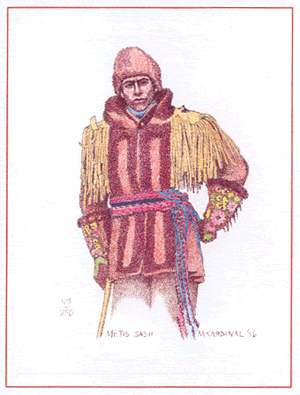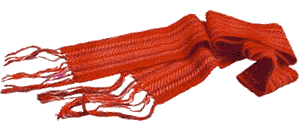 |
|
|
The sash does not only have sentimental values to the Metis it also served practical functions. The Metis used the sash as a tumpline (scarf that holds heavy objects to the back) first aid kit, rope, clothing, wash cloth and towel, saddle blanket and the ends of the sash would serve as an emergency sewing kit on trips. The sash has adopted many variations of colors over the years that now include blue and white, red, black, yellow and green. The blue and white stands for one of the national flags that is blue with a white figure eight in the middle. The red sash represents the other national flag that is red in color and has a white infinity symbol as well. The black sash is a symbol of the dark era of the Metis people. At this time the Metis had their land taken away and were being beaten and shot on the streets of Winnipeg. Yellow that is used on both sides of the sash is presented to those who are honoured by the community. Green symbolises expansion and success of the Metis Nation and the reclaiming of their honourable status in Canada. Here are some excerpts from a Metis priest's prayer: "Metis people, God, have been wearing the sash proudly for years. When I look at it, I notice that is composed of many interconnected threads, many strands, many patterns, many colors contribute to the overall design of the sash. Our Metis culture God is like the sash. The lives of the Metis have been woven together from a variety of cultures, traditions, and beliefs...For example, God, we are the descendants of the English, of the French, of the Inidan-Cree and Ojibway and Scots to name a few. We speak a variety of languages: English, Canadian French, Michif French, Michif Cree and Mashkegon. Look at the sash: it is a composite. It is a mixture. It is Metis. It is made of a variety of elements, like the lives of the Metis. Look at its pattern, its fabric, its colors. Nonetheless, these disparate elements form an integrated whole. Similarily, the different ethnic backgrounds and different languages to the Metis blend into one another to form a rich tapestry like the lives and culture of the Metis." '93
Metis Cultural Reunion - Metis Resource Centre |
Copyright © 2001 Alberta Metis Historical Society
 The
Metis people are known for their finger woven sashes that are traditionally
tied around the waist to hold a coat closed with the fringes hanging
down. Women have found a style of hanging the sash over the shoulder
and connecting it at the side of the waist. Today the belt is made
of wool and is approximately three metres long but before the introduction
of wool the sash was made with plant fibres. The Metis people are
not the only ones that have used the sash. The sash is shared with
two other groups one is the eastern woodland Indians who wore the
sash in the 19 century before any one else. The other group that
used the sash was the French Canadians during an uprising in 1837
called the Lower Canadian rebellion. The three groups have the same
outlook towards the sash in that it holds cultural distinction and
pride. Another common name for the sash is L'Assomption that comes
from the name of a Quebec town that it was produced in first.
The
Metis people are known for their finger woven sashes that are traditionally
tied around the waist to hold a coat closed with the fringes hanging
down. Women have found a style of hanging the sash over the shoulder
and connecting it at the side of the waist. Today the belt is made
of wool and is approximately three metres long but before the introduction
of wool the sash was made with plant fibres. The Metis people are
not the only ones that have used the sash. The sash is shared with
two other groups one is the eastern woodland Indians who wore the
sash in the 19 century before any one else. The other group that
used the sash was the French Canadians during an uprising in 1837
called the Lower Canadian rebellion. The three groups have the same
outlook towards the sash in that it holds cultural distinction and
pride. Another common name for the sash is L'Assomption that comes
from the name of a Quebec town that it was produced in first.